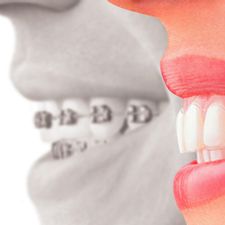Invisalign clear braces can be a fantastic alternative to traditional orthodontics. That said, they aren’t right for everyone. Before you start on Invisalign treatment at SF Dental, we will assess your case to determine whether it’s a good fit for you. In the meantime, read more about the benefits and drawbacks of straightening your teeth with Invisalign:
Benefits of Invisalign
Better appearance. The main reason patients choose Invisalign aligners over traditional wire braces is because they are less noticeable. Invisalign aligners are clear, and most people you interact with on a daily basis won’t even notice you’re wearing them.
Less infection. Because Invisalign aligners can be taken out, you always remove them before meals. That gives you the chance to thoroughly clean both the aligners and your teeth after eating. For that reason, patients with Invisalign tend to have less plaque build-up and gum inflammation than patients with traditional braces—and that means fewer cavities and less gingivitis.
Less root resorption. Traditional braces can sometimes cause damage to the structure of your teeth roots (resorption) and decrease their strength over time. Invisalign uses less torque than wire braces, and research has shown that Invisalign patients usually have fewer root resorption issues. That means better long-term health for your teeth.
More Comfortable. Many patients report that Invisalign aligners are more comfortable than wire braces. The aligners are changed every two weeks instead of the monthly adjustments more typical for traditional orthodontics. Because each alignment step is smaller, the shift is usually less painful for your teeth.
Disadvantages of Invisalign
Requires self-discipline. You have to remember to take your aligners out, clean them, and put them back in at every meal. Some patients find this difficult to do. If you forget too often, you may not see the results you were expecting, or the treatment may fail in other ways.
Can take longer. Certain types of orthodontic treatments—but not all—are faster if performed with traditional braces.
Not appropriate for all issues. Invisalign is best for specific types of bite adjustment. If you need to rotate the canines or premolars, or if your teeth need to move vertically, Invisalign may not provide you with ideal results. In those cases, traditional orthodontics may be a better choice. Before you start treatment, we will evaluate the alignment of your teeth to determine whether or not Invisalign is a good fit for your situation.
Requires careful cleaning. The oral health advantages of Invisalign disappear if you are not careful about cleaning your aligners and brushing your teeth. Patients who have preexisting oral hygiene issues may not be good candidates for Invisalign.
Further Reading
- Djeu, G. et al. (2005). ”Outcome assessment of Invisalign and traditional orthodontic treatment compared with the American Board of Orthodontics objective grading system.” American Journal of Orthodontics and Dentofacial Orthopedics.




